The Best Trucks & Vans for Electricians


The Best Trucks & Vans for Electricians
With the varying styles of work vehicles to choose from in today’s market, it can be challenging to identify which vehicles best suit an electrical contractor’s needs. Electricians need a work truck or van able to transport awkward materials, ladders, and plenty of secure storage for specific equipment. Here are three great options for work vehicles for electricians.
Cargo Vans for Electricians
Electricians carry a wide variety of tools and small parts that must be protected, so Cargo vans are an excellent option, providing secure storage and relative affordability.
“We use vans for a few reasons. For one, they keep everything enclosed from a security standpoint. They are also great for moving through alleyways where larger vehicles would have difficulty. And, parking is far easier with the vans.”
—Gary Chamberlain, Operations Manager at Cote Electric in Manchester, NH.
Vans are available as empty cargo vans waiting to be outfitted to your specific needs, or upfitted cargo vans with shelving, lighting, ladder racks, etc., already installed, saving you the time and headache of doing the work yourself.
Here is just one example of a major OEM cargo van suitable for electricians;
Ford Transit 350 Cargo Van
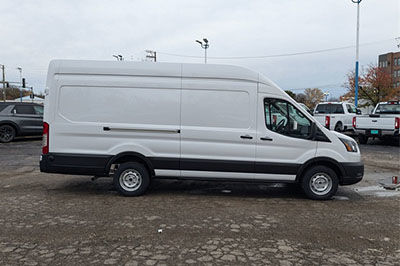
Ford’s Transit cargo vans are a great example of an all-around workhorse for electricians. For example, the Transit 350 High Roof is a popular choice for businesses and individuals needing a spacious and capable cargo van. Here's a breakdown of its key technical specifications:
H4 - Ford Transit 350 High Roof Specs
Engine Performance:
- Engine: 3.5L PFDi V6 Flex-Fuel (standard)
- Horsepower: 275 hp @ 6,250 rpm
- Torque: 260 lb-ft @ 4,000 rpm
- Transmission: 10-speed automatic with overdrive
- Drivetrain: Rear-wheel drive (standard) or four-wheel drive (available)
Interior Space:
- Cargo Volume (behind 1st row): 404.3 cu. ft. (standard wheelbase) / 487.3 cu. ft. (extended wheelbase)
- Maximum Cargo Volume: 453.4 cu. ft. (standard wheelbase) / 536.4 cu. ft. (extended wheelbase)
- Cargo Length (max): 126 inches (standard wheelbase) / 148 inches (extended wheelbase)
- Cargo Width (max): 70.2 inches
- Cargo Width (between wheelhouses): 54.8 inches
- Cargo Height: 56.9 inches
Fuel Efficiency:
- Fuel economy estimates vary depending on driving conditions and vehicle configuration. The EPA does not provide official fuel economy ratings for cargo vans. However, you can expect the Transit 350 to achieve fuel economy in the range of 15-20 mpg on the highway.
Customizable Options:
The Ford Transit 350 High Roof offers a wide array of customizable options, allowing you to tailor the van to your specific needs. These options include:
- Drivetrain: Rear-wheel drive (standard) or all-wheel drive
- Wheelbase: Standard or extended
- Roof Height: High roof (standard)
- GVWR: Multiple options available, affecting payload and towing capacity
- Seating: Options for driver and front passenger seats, including cloth or vinyl upholstery
- Cargo Management: Various shelving, racking, and storage solutions
- Towing: Trailer tow package
- Technology: Upgraded infotainment systems, navigation, and connectivity features
- Exterior: Different paint colors, wheel options, and accessories
- Safety: Advanced safety features like blind-spot monitoring, lane-keeping assist, and adaptive cruise control
Note: Specifications may vary slightly depending on the model year and trim level. It's always best to consult the official Ford website or your local Ford dealer for the most up-to-date and accurate information.
The Transit 350 is also available as the E-Transit 350 for those looking to go electric.
Utility Vans for Electricians
Utility Vans come at a higher price point than cargo vans but offer a more comprehensive storage and organization system. Many Utility van packages include adjustable interior and exterior shelving and interior lighting to make life easier in the darker months or late-night work. Wire nuts, receptacles, various conduit lengths, and tools all have their place in the utility van body. With a high-roof option, these units are top-of-the-line vehicles.
Utility body manufacturers like Knapheide and Reading offer high-quality ergonomic solutions for organization and security.
Here is just one example of a major OEM utility van suitable for electricians;
Chevy Express 3500 Utility Van
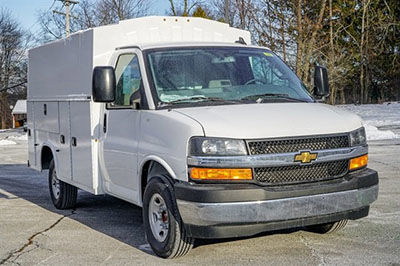
The Chevrolet Express 3500 Utility Van is a workhorse known for its power and durability. The Chevy Express 3500 Utility Van is highly customizable, catering to a wide range of commercial needs. Here's a breakdown of its key technical specifications:
Chevy Express 3500 Utility Van Specs
Engine Performance:
- Engine: 6.6L V8 (standard)
- Horsepower: 401 hp @ 5200 rpm
- Torque: 464 lb-ft @ 4000 rpm
- Transmission: 6-speed automatic
- Drivetrain: Rear-wheel drive (standard) or four-wheel drive (available)
Interior Space:
- Cargo Volume (behind front seats): Around 283 cu. ft. (This can vary slightly depending on the configuration)
- Cargo Length (max): Approximately 127 inches (This can vary slightly depending on the configuration)
- Cargo Width (max): Approximately 72 inches
- Cargo Width (between wheelhouses): Approximately 52 inches
- Cargo Height: Approximately 50 inches
- Fuel economy is not a primary focus for heavy-duty trucks. Expect significantly lower MPG than light-duty trucks. The EPA does not provide official ratings.
Customizable Options:
- GVWR: Multiple options available, significantly impacting payload and towing capacity. This is a critical consideration for commercial users.
- Wheelbase: Regular or extended wheelbase.
- Body Styles/Configurations: Specialized bodies can be fitted to the chassis, including utility bodies with tool compartments and other custom configurations designed for specific trades and applications. These upfitted bodies are typically sourced from third-party manufacturers.
- Doors: Various door configurations are available, including sliding side doors, rear cargo doors (with or without windows), and different window arrangements.
- Seating: Options for driver and front passenger seats, including cloth or vinyl upholstery.
- Cargo Management: Numerous upfitting options are available through third-party vendors, including shelving, racks, drawers, and other storage solutions.2
- Technology: Options include upgraded infotainment systems, navigation, Bluetooth connectivity, and driver-assistance features.
- Trailering: The Express 3500 is often used for towing, and various trailering packages and equipment are available.
Important Notes:
- Because of the wide range of configurations and upfitting possibilities, it is crucial to consult with a Chevrolet dealer or upfitter to get precise specifications and ensure the van meets your exact requirements. Payload capacity, in particular, is heavily dependent on the chosen GVWR.
- Specifications can change from year to year. Always refer to the official Chevrolet website or a dealership for the most current information.
Service Trucks for Electricians
Service trucks are an excellent option for any electrician, especially contractors, looking for a vehicle that can haul, tow, and transport supplies. The service truck is valuable for its multi-purpose functions. Not only can it tow heavy equipment and have the bed loaded with supplies and tools like compressors, but it can also transport more crew members if you choose a crew cab. These are all reasons why the service truck is a mainstay in the electrical trade, especially on the construction side.
Here is just one example of a major OEM service truck suitable for electricians;
Ram 2500 Tradesman Service Truck
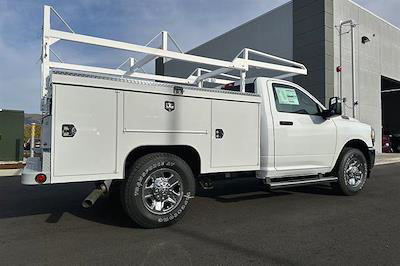
The Ram 2500 Tradesman Service Truck is a heavy-duty pickup designed for work, offering a balance of capability, power, and versatility. Here's a breakdown of its key technical specifications:
Ram 2500 Tradesman Service Truck Specs
- Engine: 6.4L HEMI V8 (standard)
- Horsepower: 410 hp @ 5600 rpm
- Torque: 429 lb-ft @ 4000 rpm
- Transmission: 8-speed automatic
- Available Engines: 6.7L Cummins Turbo Diesel I6 (optional) - Power and torque figures vary depending on the specific version of this engine.
- Drivetrain: Rear-wheel drive (standard) or four-wheel drive (available)
- Body Styles/Configurations: Specialized bodies can be fitted to the chassis, including utility bodies with tool compartments and other custom configurations designed for specific trades and applications. These upfitted bodies are typically sourced from third-party manufacturers.
- Seating: Options for front captain chairs or bench seats, can include second-row seating with crew cab option.
- Crane/Liftgate Compatibility: Some service bodies are designed to accommodate cranes or liftgates.
- Fuel economy is not a primary focus for heavy-duty trucks. Expect significantly lower MPG than light-duty trucks. The EPA does not provide official ratings.
Customizable Options:
- Trim levels: Tradesman is the base work truck trim.
- GVWR: Multiple options available, significantly impacting payload and towing capacity. This is a critical consideration for commercial users.
- Wheelbase: Regular or extended wheelbase.
Important Notes:
- Specifications for the truck itself can change from year to year. Always refer to the official Ram Trucks website or a dealership for the most current information.
Choosing the Right Work Truck for Electricians
Choosing the best work truck is crucial for electricians. Cargo vans, utility vans, and service trucks are the most common options, each with distinct advantages.
Cargo vans offer enclosed storage, protecting tools and materials from weather and theft. They are generally more affordable and maneuverable than utility vans and service trucks, ideal for residential work or smaller jobs.
Utility vans provide significantly more storage and payload capacity than cargo vans, but these improvements come at a cost. Utility vans excel as serious service vehicles.
Service trucks excel as mobile workshops. Their customizable service bodies offer superior organization with compartments, shelving, and work surfaces. They are best suited for larger commercial or industrial projects requiring extensive on-site work and heavy payload/towing capacity. Crew cab configurations are available to transport multiple workers.
Consider these factors when assessing the right vehicle for your business needs:
- Job Type: Residential, commercial, industrial?
- Equipment/Materials: Size, weight, quantity?
- Budget: Purchase price, upfitting, fuel, maintenance.
- Payload/Towing: How much weight will you carry/tow?
- Customization: How much organization do you need?
Key Decisions: Enclosed storage (vans) vs. mobile workshop (service truck)? Payload/towing requirements? Passenger/crew capacity?
For residential work, cargo vans often suffice. Depending on project size and on-site work needs, electrical contractors may choose a utility van or service truck. Industrial electricians frequently prefer service trucks for their payload, towing, and mobile workshop potential.
UPDATED ON: March 19, 2025
Published on: September 10, 2019 Work Truck Solutions and J.D. Power Launch Commercial EV Hub
Work Truck Solutions and J.D. Power Launch Commercial EV Hub Class 2b-3 Commercial Vehicles: How the Industry Can Find the Right Balance Across Supply, Demand, and Emissions Requirements
Class 2b-3 Commercial Vehicles: How the Industry Can Find the Right Balance Across Supply, Demand, and Emissions Requirements Class 2b-3 Commercial Vehicles: Where We Are and Where We’re Going
Class 2b-3 Commercial Vehicles: Where We Are and Where We’re Going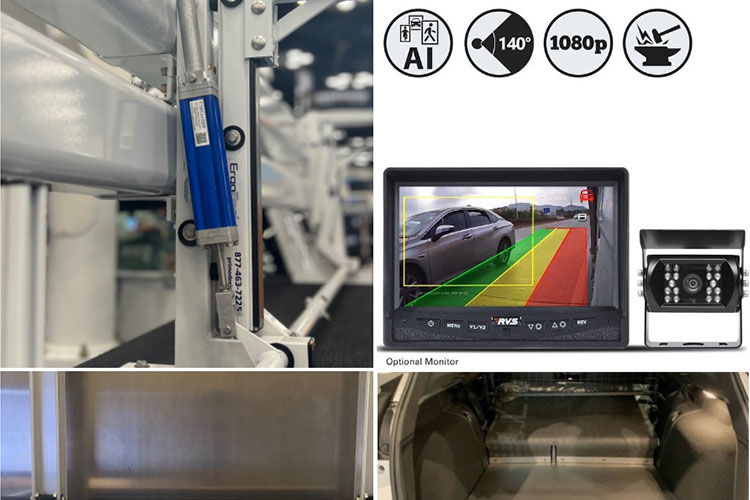 Commercial Vehicle Tech is Peaking Right Now. Here Are 4 Examples of How.
Commercial Vehicle Tech is Peaking Right Now. Here Are 4 Examples of How.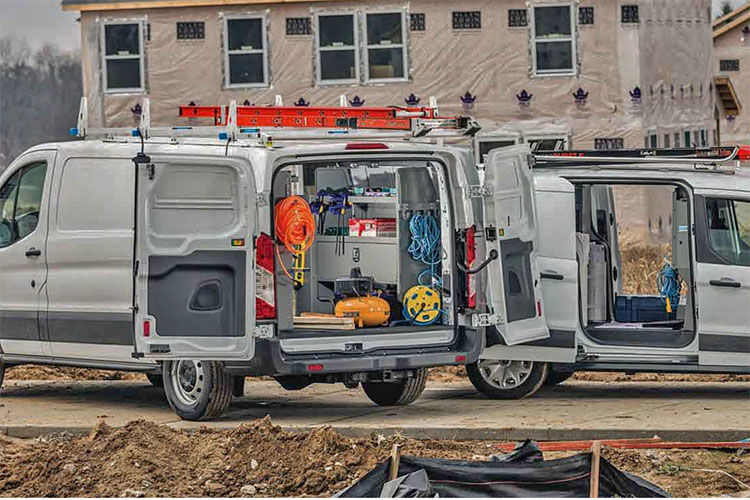 Work Truck Organization Tips and Ideas
Work Truck Organization Tips and Ideas






